Captain C.O. ‘Mick’ Jennings and MG K3007 in Malaya
By Eli Solomon
The Real Captain MG – Cyril Oswald ‘Mick’ Jennings. Source: Jennings Family Collection.

Does the name Cyril Oswald Jennings resonate in Asian motoring history circles? His contribution to immediate post-war Kuala Lumpur and Petaling Jaya housing schemes 1 in his capacity as Selangor’s municipal architect has been glazed over. To motor racing enthusiasts however, Capt. C. O. ‘Mick’ Jennings is best known as the winner of the 1949 Johore Grand Prix, and as the owner of a record-setting MG K3 in Malaya before the war. Indeed, he was an avid MG racer, and the author of An Ocean Without Shores 2, an account of his astonishing escape attempt from Singapore the day the British surrendered to the invading Japanese army in 1942. The story of his escape from Singapore, crossing to Padang and his eventual 127-day attempt to reach Australia in a small open boat, “Gilca,” are accounted in “An Ocean without Shores.” Jennings also wrote about his subsequent experience as a POW in Sumatra in an unpublished memoir he titled “Heaven Has Curtains.”
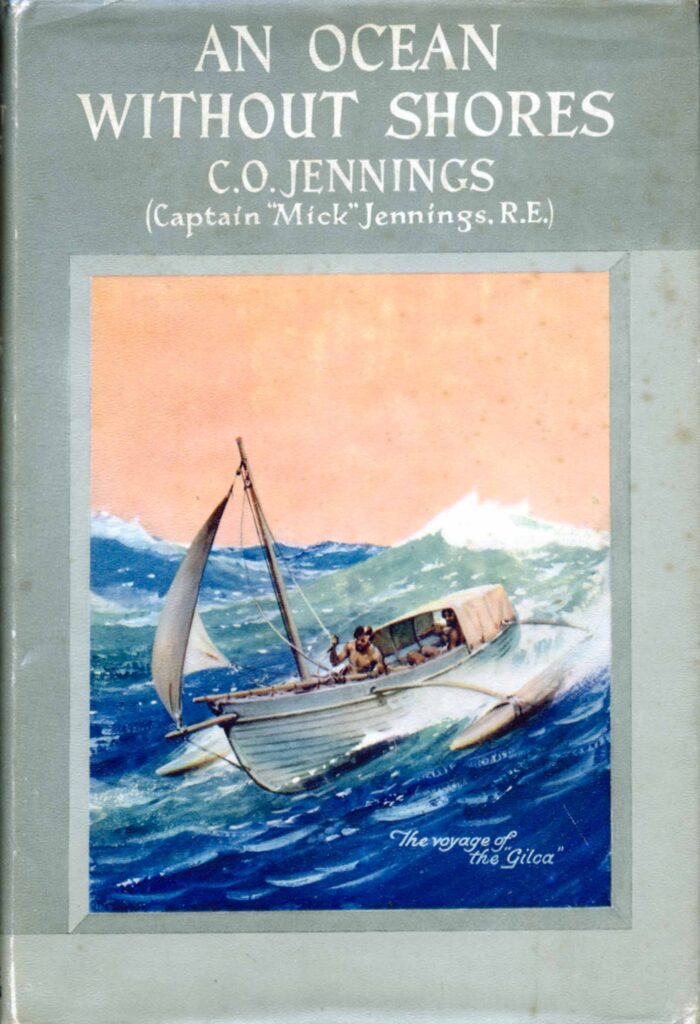
An Ocean Without Shores was first published in 1950. It was reviewed in the Singapore Standard, 2 August 1950 (p.3). 2,500 copies of the Hodder and Stoughton book were dispatched to Kuala Lumpur for display in early August 1950. The book was priced at Malayan $7.50.
RACING AGAINST TIME
Jennings, a 5ft 7in Yorkshireman born in 1899, was a government building inspector in Kuala Lumpur, having been posted to Malaya in 19353. Jennings first stepped foot on Malayan soil on 10 May 1935, a year after Sir Shenton Thomas arrived in the Straits Settlements as its Governor (1934 to 1942). Prior to that, Thomas had been Governor of the Gold Coast Colony (present-day Ghana) from 1932 till 1934 while Jennings was a surveyor there between 1926 and 1930. Not an unusual posting for either as many of the Colonial civil service personnel were transferred to Britain’s South East Asian outposts from Africa from the mid-1930s. Both Jennings and his first wife Margery were active in social circles in Malaya before the war, often giving solo recitals on Malayan radio4. In early 1938 Jennings was also a committee member of the Kuala Lumpur-based shortwave station of the Malayan Amateur Radio Society, forerunner of Radio Malaya.
A 1937 MG PB, registration PK925, was acquired for regular commute and Jennings made his first appearance at a motor sport event in Malaya when he entered the MG at the Negri Sembilan and Malacca Branch of the AAM’s first half-mile sprint at 1st mile, Seremban-Tampin Road held on 11 September 19385. He was up against Penang racing enthusiast Harry Marriot in a similar MG PB, Roy Newman6 in the Gordon England Austin Seven, Douglas S. Ainger7 in a 1937 Riley Sprite Lynx (1,496cc), Hugh W. Dornhorst8 in an MG PB and Malacca engineer John Keene in an MG TA. The big guns included Lim Peng Han in his Ford V8 L.A. Special (Number 1), Ted Holloway9 in his Holloway Ford V8 Special, and James L. Ross11. Along with other motoring contemporaries was a committee member of the Kuala Lumpur Flying Club when Mungo Park was President of the club (1931-1932) – membership of 101 flying members. Raced a Willys 77 and a Matchless bike in the AAM Lornie Speed Trial April 1936. Listed as a Director of Klye, Palmer by October 1936. Was AAM Selangor Brach’s President April 1940. By August 1947, was already Hon. Treasurer of the St. Andrew’s Society of Selangor. When Kyle, Palmer merged with Paterson Simons in February 1961, James L. Ross was MD of Kyle, Palmer & Co.[/efn_note] in a 2½-litre SS Jaguar.
On 25 September 1938, Jennings was down in Singapore with his MG PB for the Farrer Road Speed Trial12. Here he won Class 10 for Sports Cars up to 950cc. His time of 38.8 sec. was well off Lim Peng Han’s 29.6 sec. blast in L.A. Special Number 1. Jennings had caught the bug in Malaya and henceforth his mount would primarily be an MG. In the AAM’s Central Rally held on 15 January 1939, the 200-260mile run saw 33 competitors entered. Final destination was Kuala Lumpur and Jennings emerged tops in his supercharged MG PB, beating John Keene13 (MG TA) and Margaret Braid (MG TA), wife of Lieut. Peter Karl Braid, who were joint-second.
At the Selangor and Pahang Branch’s AAM’s Lornie Road Half-Mile Acceleration Test held on 26 March 1939, Lim Peng Han’s L.A. Team consisted of Eric L. Williams (in Wong Chek Quee’s Frazer Nash-BMW), Lieut. Peter K. Braid (MG TA) and Lim in his V8 L.A. Special. Judge Conrad Oldham’s team consisted of himself in his Ford V8 Saloon, a Lieut. Gordon in a Ford V8 Coupe and Jimmy Milne in his Ford V8 Saloon. It may have appeared that none of this was serious stuff and merely a weekend of fun out in the tropics except that for people like Lim, whose business was beginning to depend on how many expatriates commissioned a Special from him, and those intrepid characters from Federal Motors (Fiat and Triumph agents), Wearne Brothers (Universal Cars in particular) and Borneo Motors (Austin agents), this was really the formative years of Win of Sunday, Sell on Monday.
Jennings, perhaps by virtue of his seniority (he was now 40), had John Keene and Ted Holloway on his ‘Blown’ Team while another, called the ‘Number 4’ team, consisted of Hugh Dornhorst, Harry Marriott and Jimmy Milne. Jennings’ Blown team won the team prize, his supercharged MG PB winning the Sports Cars 1,550cc class. He finished third fastest in the Sports Cars 2500cc class. Lim Peng Han’s disastrous weekend is document in the chapter on the Malayan Special.
There wasn’t much rest before the Perak AAM’s Easter Holiday festival Gopeng Hill Climb was held on 9 April 1939. It wasn’t an easy drive up in racing cars, towed or otherwise, but as usual, Lim and his mates were up for the challenge to wrestle the Storch Cup for Fastest Time of Day from Wearne Brothers’ Hugh G. Oates. Lim’s team consisted of Judge Oldham, Lieut. Peter Braid and himself and this time, they bagged the team prize. With such MG competition coming from Harry Marriott, Hugh Dornhorst and Lieut. Peter Braid, it was no wonder that Jennings was limited to a Team Prize 3rd placing for the Selangor Team of Fiat owner S. Kuppan, MG owner John Keene and himself.
It appears that Jennings and Margery missed the Gap Hill Climb in Singapore on 11 June 1939 as the couple had departed for Britain on home leave on P&O’s Rajputana14 on 2 June 1939, having been stationed in Malaya since 1935. Holidays for the couple had thus been limited to such locations as the salubrious Mount Pleasure Hotel in Penang, which offered a stunning view of Kedah’s mountain peak. Also, Jennings had been studying for the qualification of Associate of the Royal Institute of British Architects during his Malayan tour and when the couple returned to the UK in 1939, “he received three months of intensive coaching and then sat the whole five years’ architectural exams at one time.”15
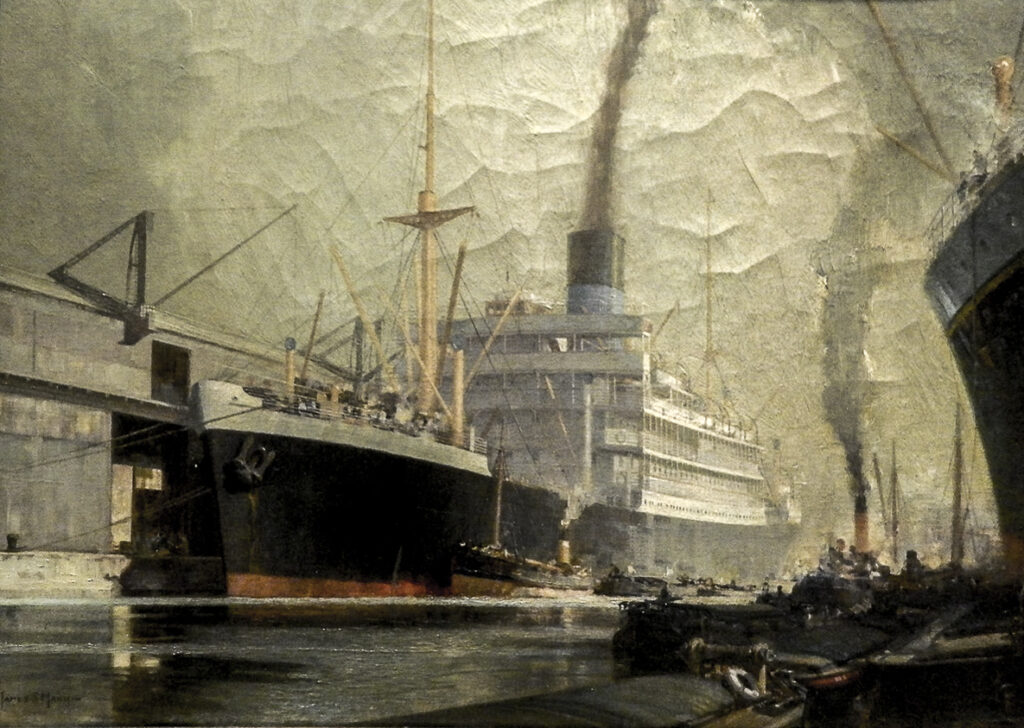
Mick and Margery Jennings returned from their UK vacation aboard the Sarpedon in February 1940. His newly acquired MG K3 was probably in the cargo hold of the vessel. Oil on canvas painting by J.S. Mann of the 11,321 Blue Funnel liner Sarpedon in Gladstone Dock, Liverpool. The painting is in the Museum of Liverpool. This vessel was the fourth of six Blue Funnel ships to bear the Sarpedon name. Source: By Bazonka – Own work, CC BY-SA 3.0, https://commons.wikimedia.org/w/index.php?curid=31342247
A Straits Times correspondent in Britain reported on 20 January 194016 that Jennings, “…the well-known Kuala Lumpur racing motorist, is now on his way back to Malaya after a year’s leave in England. He saw a great deal of British motor sport before the war broke out and hopes, as a result of his experience, to clip a few more fifths off his speed trial times when he gets back. Mr Jennings said, before sailing, that he hoped to be able to organise motoring meetings on behalf of the Malayan Patriotic Fund, and that he would try to inaugurate a small car club in Kuala Lumpur.”17 The birth of the Selangor Motor Sports Club [see MICKEY BOY’S BADGE] would have to wait a decade before it materialised. However, in Jennings’ carry-on luggage was a weapon that would take off more than a fifth of his speed trial times.
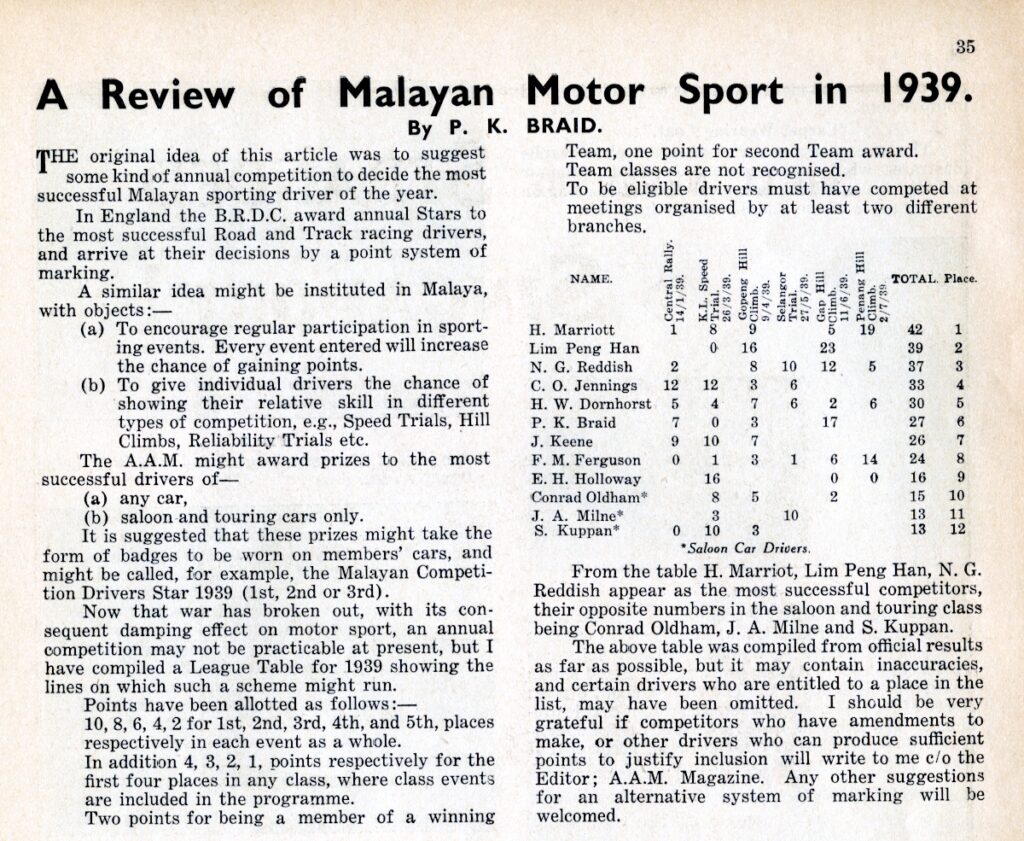
Mick Jennings’ racing record in 1939 placed him in fourth place. It would have been higher had he not been away when the Gap and Penang Hill Climbs were held. Source: Motoring in Malaya. September 1939 – RMA Collection
THE LEGEND
To us MG petrol heads, Jennings is a legend, the man who raced the supercharged MG K3 Magnette (chassis K3007), the very car that British racing legends Ron Horton and Major Goldie Gardner set numerous records in. Jennings acquired it from the MG factory in Abingdon in September 1939 while on home leave, just as war was declared on Germany. The car had been dismantled at Abingdon in 1938 and its original engine (28AK) was installed in MG’s EX 135 record car (K3023). In March 1938, the car was put up for sale. This was the car that journalist Denis Jenkinson referred to as “a highly-developed track-racing car.” Amidst all the chaos of shipping disruptions, the chassis (now with engine 29AK and ENV manual gearbox18) miraculously managed to avoid being torpedoed by enemy U-boats and made it safely to Malaya by early 1940, probably on the same vessel that brought Jennings and Margery back19. Jennings’ tukang [Malay for craftsman/fabricator] in Kuala Lumpur quickly set to work to fabricate a new alloy single-seater body for the K3. The car broke cover in May 1940, road registered B2335.
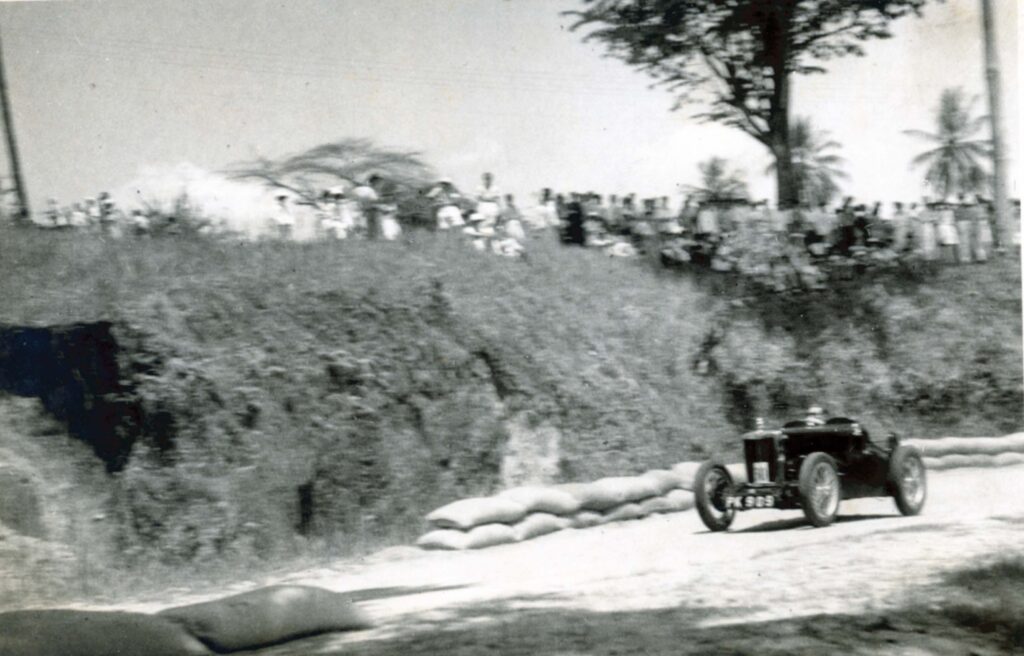
The Gopeng Hill Climb was held over Easter weekend on 24 March 1940. Jennings’ Supercharged MG PB was still Malayan registered (PK925). He finished third.
Jennings missed the Penang and Kedah AAM Mount Pleasure Hill Climb held on 9 February 1940 but over Easter he attended the Gopeng Hill Climb on 24 March 1940 in his supercharged MG PB. One presumes the K3’s body hadn’t been completed in time for the Perak race weekend. He missed the Singapore and Johore AAM’s 28 April 1940 Gymkhana next to the Keppel Golf Club in Singapore but by 12 May, both the PB and K3 were ready for the Negri Sembilan-Malacca Branch of the AAM’s Whit Sunday Seremban Half-Mile Standing Start Sprint20 at 1st Mile Seremban-Tampin Road. There were 73 entries with 14 teams participating and team Jennings had two very potent entries with Jennings looking to harness the power of the MG K3 to overturn Lim Peng Han’s record established a year earlier.
The entry list was made up of familiar names. Harry Marriott with his supercharged MG PB and Lim Khye Su with his 2½-litre SS100 Jaguar21 were heading down from Penang while Perak-based brothers James George Milne ‘Bill’ Ferguson (28) and Freddy Milne Ferguson had MG TAs22 (neither attended this race). Wearne Brothers’ Hugh Oates had an MG Special (MG PB registration PK1784) while Federal Motors’ Charles Vernon Crowther-Smith had his Fiat Victoria Special. Malacca engineer John Keene had a newly-built Ford V8 Special to replace his MG. Kuala Lumpur dental surgeon Hugh W. Dornhorst had a thoroughbred, a Frazer Nash-BMW 328 which the press reported as a “Grand Prix Frazer-Nash-BMW”. Borneo Motors’ Roy Newman had the ex-Sultan of Perak Gordon England Austin Seven while Neville George ‘Red’ Reddish had his supercharged Austin Seven, listed as a T.T. Austin. From the south came Lim Peng Han and the L.A. squadron – Lim, Lieut. Peter Braid, Judge Conrad Oldham and Fl/Lt. Anthony Phillips. Wong Chek Quee was listed with a supercharged 120mph Maserati (4CS) and Malayan Broadcasting man John Barraclough had the ex-Wong 2½-litre Jaguar SS100. Would Jennings now be able to take on the big guns of Malayan motor racing with the former record-breaking MG K3?
Jennings’ MG PB was entered in Class 6 and 7 for Sports Cars up to 1,500cc. Here he faced Lim Peng Kooi’s Wolseley Hornet (1272cc), Lieutenant S.A. Potter’s 1938 MG TB, Lieutenant Peter Braid’s MG TA, Reddish’s supercharged Austin Seven T.T. (raced by fellow Borneo Motors colleague John Wheeler23) and Roy Newman’s Gordon England Austin Seven. Braid and Wheeler came out tops and Jennings’ time is not recorded.
Jennings also entered the car in Class 9, for Sports Cars Unlimited. Here he faced G.E.N. ‘Geno’ Oehler’s 3917cc Mercury Coupe in the hands of Geno’s buddy Jimmy Milne. There was also John Barraclough’s SS100, Harry Stratton Brown’s 1932 2-litre Bugatti, Captain R.D. Bell R.A.M.C.’s Alvis Speed Twenty, Wheeler in Reddish’s T.T. Austin Seven and Alfred Giles Faber’s24 1938 3½-litre Jaguar SS Coupe. Barraclough won ahead of the Stratton-Brown Bugatti and Jimmy Milne in the Oehlers Mercury Coupe.
In Class 10 for Racing Cars up to 1,500cc, Jennings’ supercharged MG K3 would face some serious machinery such as Wong’s 1938 1,496cc Maserati 4CS, Richard Whitman’s Bitzer Special (1,445cc), Charles Crowther-Smith’s little Fiat Special, Geoffrey Maund’s Austin Seven and Arthur Loughborough in Peter Braid’s L.A-Braid monoposto. The K3 was expected to win easily but teething issues continued to plague Jennings. Loughborough won ahead of Crowther-Smith.
In Class 11, where anything went, the K3 had Oldham’s V8 L.A. Ghost, Reddish’s ChevRemban Mk2, Wong’s Maserati, Anthony Phillips’ L.A. Special Number 1, Whitman’s Bitzer (with Tam Wee Fun driving), Crowther-Smith’s Fiat Special, Lim’s new V8 L.A. Special and Ted Holloway’s Holloway Special. Phillips won in the L.A. Special. Lim stripped his timing gears but managed to finish second, ahead of Oldham’s Ghost.
Not altogether a great start for the K3 but there was still the War Effort Gap Hill Climb in Singapore on 4 August 1940. There was also a buzz in the air (there were no brownouts or air raids at that point in Singapore), rumours of a big race later in the year.
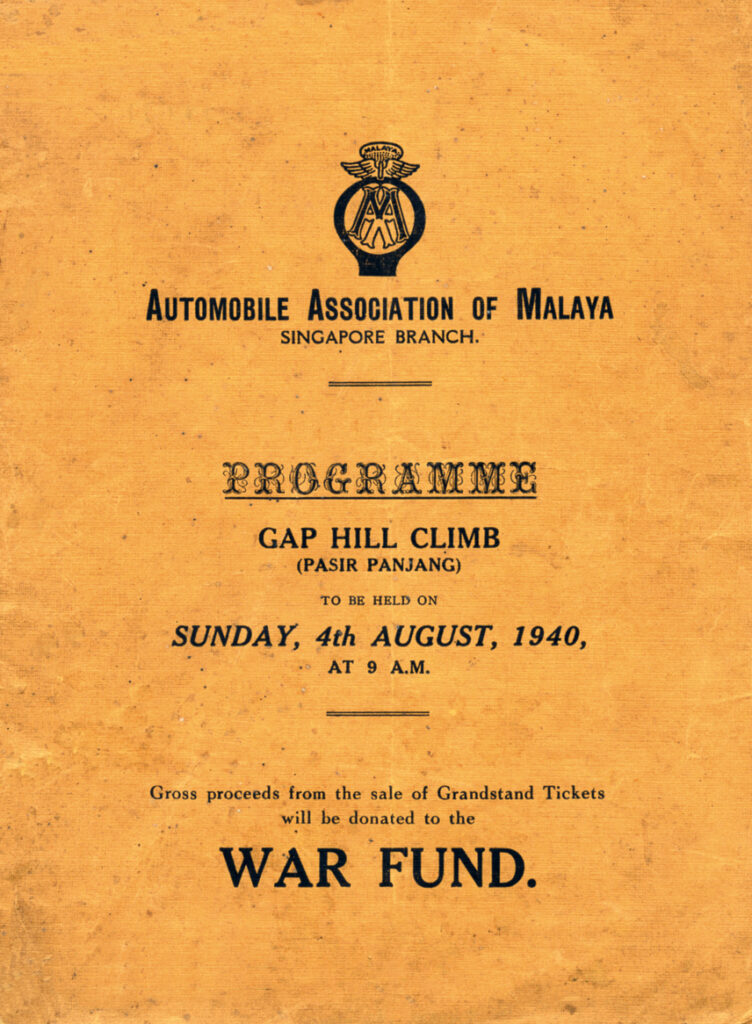
The War Effort Gap Hill Climb was held on 4 August 1940. Source: RMA
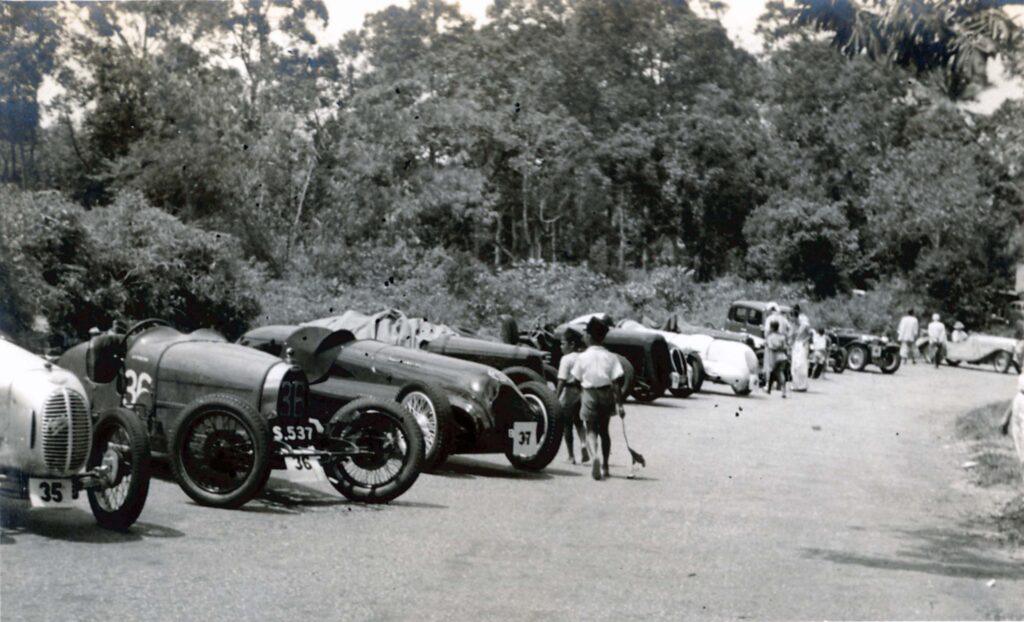
The 1940 War Effort Gap Hill Climb in Singapore. The #36 Bugatti is a 1926 Type 37 with unsupercharged 1,496cc motor entered by Lim Peng Han. Next to the Type 37 is Jennings’ MG K3 (#37). The white Special to the right is Conrad Oldham’s L.A. Ghost and to the Ghost’s left is Ted Holloway’s Holloway Special.
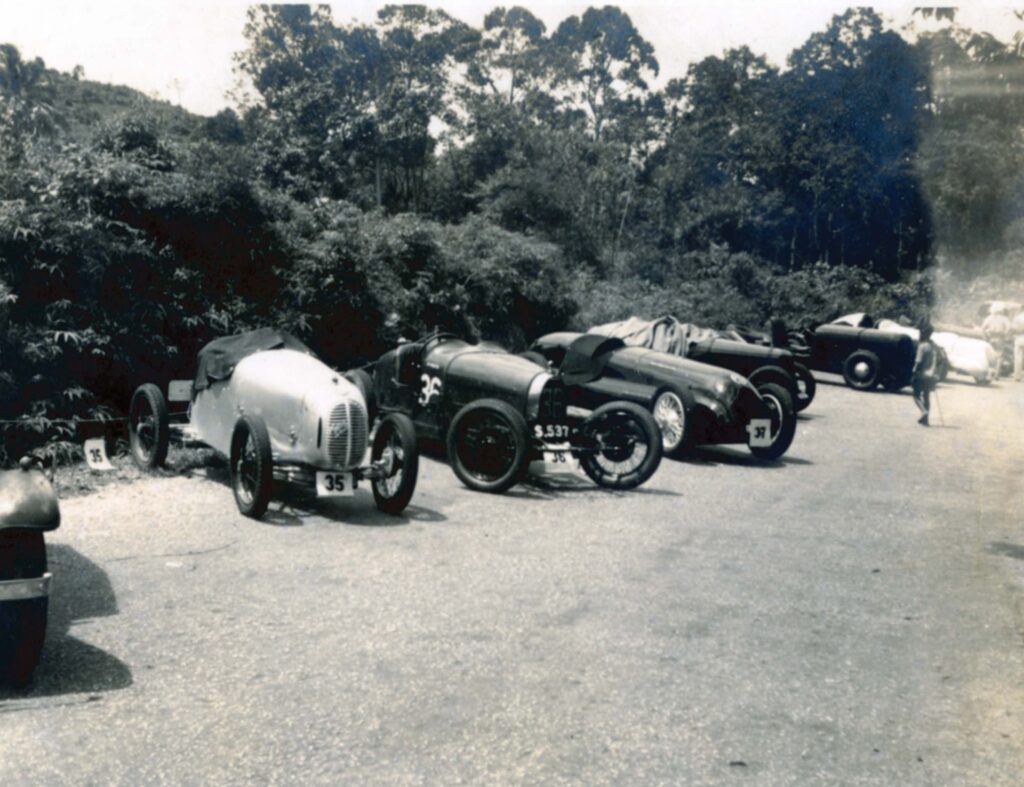
At the 1940 Gap Hill Climb with the Type 37 Bugatti alongside the K3 MG.
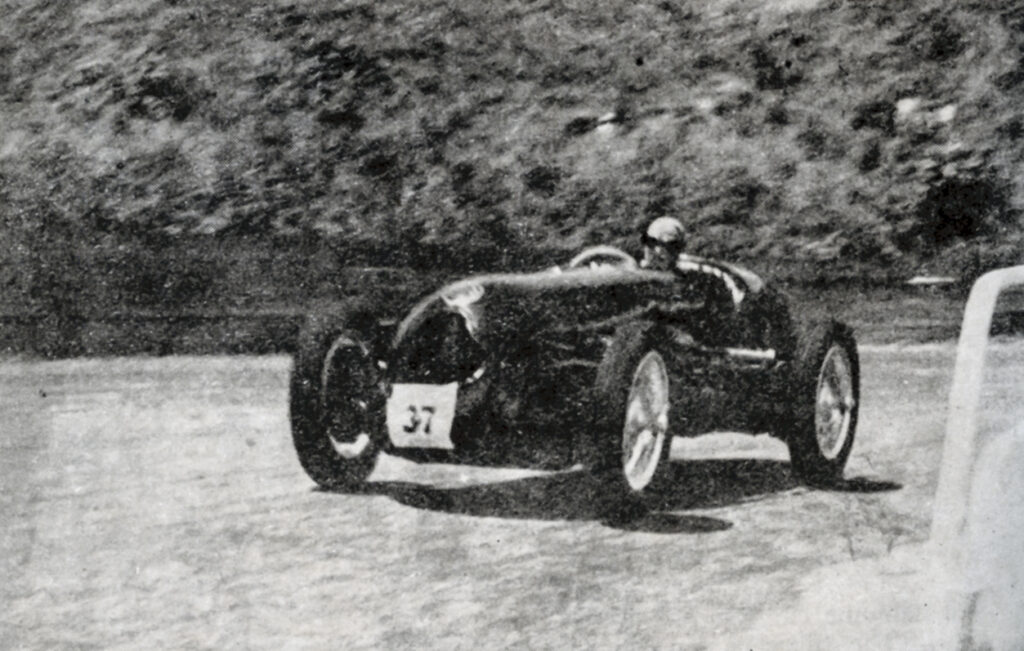
The K3 in action at the War Effort Gap Hill Climb in 1940. SourceL MSVCR Magazine, February 1971
The Gap in August was extremely well attended with around 60 entries received. It was an exciting weekend of War Fund raising with events at the Johore Civil Service Club, Alexandra Garrison Sergeants Mess, the Malayan Tennis Championships in Singapore, the Gap Hill Climb and a Scavenger Hunt at the Airport Hotel, the Monday being a Bank Holiday. Because the grandstands were repositioned to accommodate spectator interests, there was also a very good crowd that packed the two grandstands overlooking Conrod Corner and the finishing line. Tickets cost $2.00 each and were on sale at John Little’s, presumably at Raffles Place, Singapore.
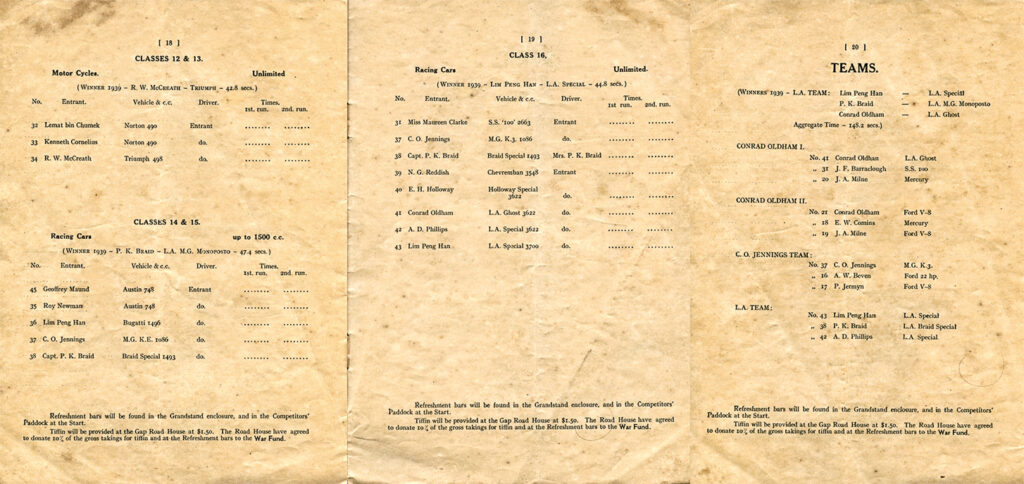
The relevant entry lists for the 1940 Gap Hill Climb, showing the K3 entry as well as Mick Jennings’ team entry that included famous Malayan jockey Arthur William Beven and Chief Paddock Marshal, and committee member of the Singapore Branch of the AAM, Lt. Peter Jermyn R.A. Source: War Effort Gap Hill Climb program – RMA Collection
The K3 was still a work in progress with its replacement engine and ENV gearbox and totally new bodywork25. Jennings faced another monoposto in the Racing Cars up to 1,500cc class in Capt. Peter Braid’s Fiat-engined (1493cc) Braid Special. But then there were a number of other very fast cars entered – Neville Reddish’s Chevremban V8 and Lim Peng Han’s V8 L.A. Special, not to mention the other L.A. Specials he’d built for Conrad Oldham and Fl.Lt. Anthony Phillips, and of course Ted Holloway’s 3,622cc revised Holloway Special. Lim set FTD at 43.6 sec. while Capt. Braid was second fastest with a 43.7 sec. run in the Racing Cars up to 1,500cc event, beating the K3 to second (46 sec) and Geoffrey Maund (Austin 7) to third. Jennings was also entered in the team event comprising himself, in the K3; famous Malayan jockey Arthur William Beven26 in a 2.2-litre Ford Saloon; Chief Paddock Marshal, and committee member of the Singapore Branch of the AAM, Lt. Peter Jermyn R.A.27, in a Ford V8 Roadster.
GRAND EPREUVE
No one had expected another attempt to host a Grand Prix in the Far East following the cancellation of the Malayan Grand Prix of the previous year. But it did happen, though not at Swettenham Aerodrome. The Royal House of Johore stepped forward and together with the Johore and Singapore Branch of the AAM, proposed a two weekend Grand Prix, loosely based on Brookland’s handicapping rules. November was chosen for the big event. At last, a Grand Prix in Asia!
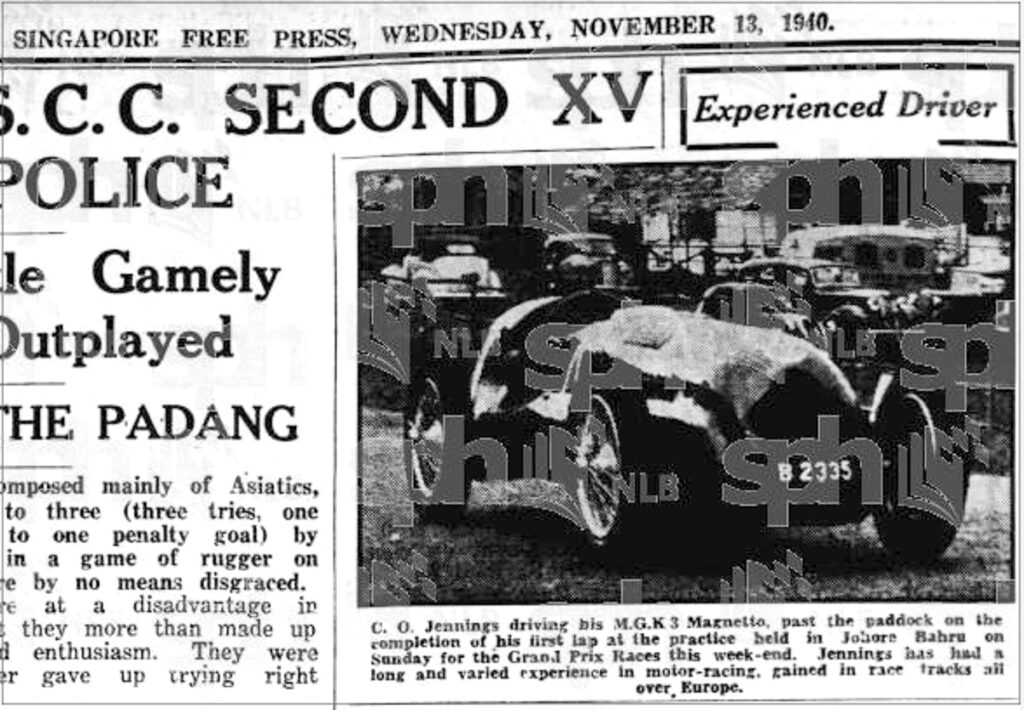
The Singapore Free Press and Mercantile Advertiser of 13 November 1940 (pg.10) featured Jennings and his MG K3.
The story of the 1940 Johore War Effort Grand Prix is described in detail in GENESIS & THE WINDS OF WAR, suffice it to say that the K328 was still untested, relative to the L.A. Specials from Lim Peng Han’s stable. And so it proved, after a trying few weekends battling weather, bad news and a totally new road circuit that amounted to a Round The Houses race.
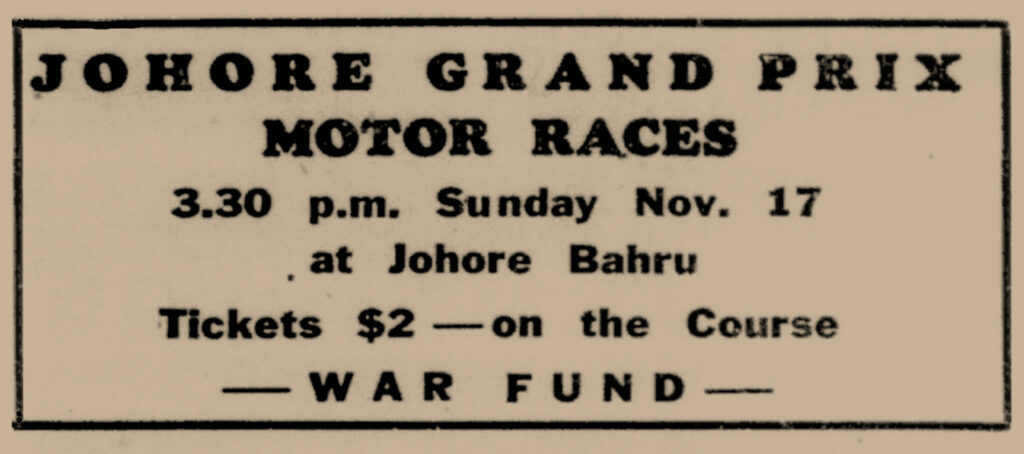
The biggest motor racing event ever held in Asia before WWII was the November 1940 Johore War Effort Grand Prix. Source: RMA
There is little doubt that the K3 would have been the most sophisticated (and most complex) car on the circuit in a grid comprising a supercharged 747cc Austin Special, a 1-litre four cylinder Fiat Victoria Special from Perak, a pair of straight-six OHV Fiat-engined L.A. Specials, a pair of 2,663cc SS Jaguars (one of which was an SS100), four 3,622cc Ford V8s, a singular Alvis Speed 20 and a Talbot-Salmson-Amilcar Special called the Bitzer (which the owner advertised for sale at $600 shortly before the Grand Prix!), to name a few.

The Malayan Morning Tribune’s full page on the Johore Grand Prix races held on Sunday 17 November 1940 (p.9) featured Jennings’ smartly fabricated MG K3 bodywork, a product of his tukang magic in Kuala Lumpur. GENESIS AND THE WINDS OF WAR
An interesting excerpt under the heading of Services’ Notes And Brevities appeared in the Malayan Morning Tribune of 30 November 1940 (pg. 6): “Lieut. C.O. Jennings (R.A.S.C)29, whose MG K.3 Magnetto (sic) earned its owner yet one more silver cup at Johore in the recent Grand Prix meeting, is a racing and rally driver of several years’ experience. He first began racing in the Inter-Varsity Trials in England in 1920 and since that time he has competed in all the principal events in England and Malaya. Lord Howe and Prince “Bira” are only two of the man racetrack notabilities against whom he has competed.” Shortly after, Jennings re-joined the Royal Engineers with the rank of Captain30. Home was no longer Kuala Lumpur and both he and Margery headed down to Singapore along with their MG PB and the K3.
ROYAL SAPPER
The Jennings’ spent their New Year (1941) at Command Gymnasium at Tanglin at celebrations given by the Fort Canning Garrison Sergeants’ Mess. Margery soon immersed herself in singing and organ performances. Jennings’ supercharged MG PB now carried Singapore registration S724, but the K3 retained its Malayan road registration. Capt. Jennings’ full time role in the Royal Engineers probably meant he had living quarters provided and this may have included provision for his two MGs.
In April 1941 Margery performed at a Gordon Highlanders event at Selarang Camp in Changi. And if one were an avid listener of the wireless [radio] and tuned into ZHL31, ZHP1 or ZHP2, one would have been able to listen to the voices of Mick and Marjory Jennings singing at 9pm in April and again in June 1941. Margery also performed in the Wesley Church Hall in Singapore, and on one occasion, she performed a solo song at the wedding of an RAAF Corporal.
In October 1941 Margery visited Cameron Highlands, staying with 44-year-old American Methodist Missionary Dr Hobart Baumann Amstutz and his wife Celeste32 at ¾ mile Ringlet Village when the Reverend spent a month on leave at Ping Shan33 from early September, the four-room bungalow of Reverend and Mrs Ho Seng Ong34 of Tanquerah, Malacca. Interestingly the visit coincided with Capt. Jennings R.E.’s move to Ipoh35. It was but a short-lived relocation because on 8 December 1941 the Japanese forces made their move into North Malaya and the seven major airfields in northern Malaya at Alor Star, Sungei Patani, Butterworth and Penang on the west coast of the Peninsula and Kota Bahru, Gong Kedah (also known as Gong Kedak) and Machang on the east coast, were bombed.
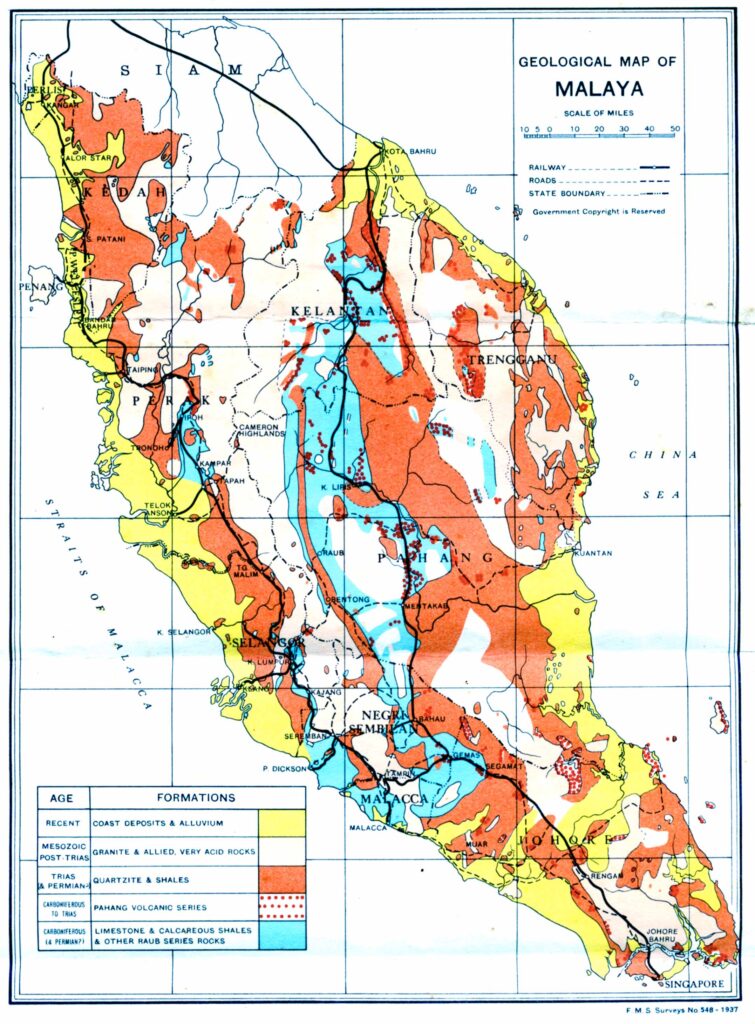
A pre-war geological map of Malaya showing the road and rail network and the course Jennings would have taken as he beat a retreat down to Singapore in his supercharged MG PB late in 1941. Source: RMA
The British Military and civilian retreat down the Peninsula began in earnest. Jennings would have had instructions to return to Singapore so the supercharged MG PB would have had to make yet another long distance run for it, once the Japanese advance began36. Jennings’ route, certainly undertaken before Christmas of 1941, would have been via the only road that linked Ipoh (which fell by 28 December), Kampar, Slim River, Kuala Lumpur (which fell on 11 January 1942), down through Seremban, Gemas and thence to Johore Bahru and across the causeway (which was disabled by the retreating forces on 31 January 1942) to Singapore. His job as a Sapper in the Royal Engineers was to deny anything of value to the enemy such as the floating dredges in the tin mines.
Years after Mick’s passing (1964), Ruth, his second wife, wrote in her diary that: “He had put the scorched earth policy into effect as much as was possible. From all accounts of the Malayan campaign, he and all Allied troops were repeatedly ordered to retreat, never making a stand until those surviving had returned over the causeway to Singapore Island.” His family recalls he fulminated on not being able to apply his expertise properly – his view was that he ought to “zoom around in his MG PB making lightning strikes, blowing up bridges…”
When Jennings ultimately reached his barracks at Tanglin Hill, probably where the present day Phoenix Park (Kay Siang Camp) stands, is not known. The Royal Engineers were based at Sapper Road, Tanglin Hill with Brigade HQ at Mount Echo. Retreat took place at the end of January 1942. On Friday 30 January 1942 Margery Jennings’ diary notes: “…we removed to the Hinches37,” in reference to the situation in Singapore, following the retreat from Ipoh. Had Mick and Margery read the Straits Times of Thursday 29 January, they would have been aware of heavy fighting around Rengit, south of Senggarang in the Batu Pahat district of Johore, and that the north western coast of Singapore island, facing the Straits of Johore, was being evacuated of civilians.
When the British surrender was announced, Jennings recalled: ” Instructions from Lt. Col. Meade38 [sic – should read Lieut. Col. C.A. Mead], Gentlemen, today at 4.30pm the British Commander-in-Chief surrendered unconditionally to the Japanese Commander-in-Chief. You are now at liberty to try to escape, or to stay, as you desire; but if you go I am to advise that you go in uniform, otherwise, if captured, you may be shot as spies. That is all. Through the shell-scarred Lion City we quickly made our way, driving over piles of rubble from shattered buildings. (In my supercharged two-seater MG sat Major Slater, R.E., with two Sappers on top of the petrol tank).”
CUSTODIAN OF PROPERTY
During the Japanese occupation, the K3 was lost and there are various stories of where it could have ended up: the K3 and Jennings’ supercharged MG PB were sunk off Laburnum Wharf as he fled the island; the K3 ended up in the Hong Kong & Shanghai Bank Mess in Singapore during the war39; the engine powered a motor boat during the war [rather unlikely]; it was sent to Japan40; it was salvaged by Lim Peng Han in Singapore…in no particular order, though the Japanese requisition was a strong possibility, given that it was spotted on Hong Kong Bank’s Mount Echo grounds at 325 Tanglin Road by POW Paul Gibbs Pancheri while on a fatigue party from his River Valley Road Camp. Following the British surrender, Mount Echo was occupied by a Japanese General. Based on Gibbs Pancheri’s account, the K3 might have been stored there before surrender or it may have been requisitioned by the Japanese after surrender and kept by a General who knew his MGs and racing cars41. Lim Peng Han too would have been aware of the car and its significance.
Jennings also lost his supercharged MG PB, his runabout he often raced at the sprints and hill climbs up and down the Peninsula. He loved his MGs too much to have pushed the PB into Laburnum Wharf42 in Singapore when, as a Sapper with the Royal Engineers, he made a beeline for the wharfs to escape capture43. Margery, who was serving with the Medical Auxiliary Services at Kandang Kerbau Hospital on Kampung Java Road and helping out at the YWCA in Singapore prior to the British surrender in 1942, was evacuated on the overcrowded HMS Mata Hari44 a few days earlier during Singapore’s “mini Dunkirk”, one of the last vessels to leave Singapore waters before the surrender. Another sentimental possession lost during the war was a Monington & Weston short compass upright piano, a wedding gift from Jennings to Margery while in the Gold Coast, Ghana, during his early career as a surveyor. Sadly, he subsequently lost Margery to the war. Her boat sank but she made it to Banka Island. She was taken prisoner by the Japanese on Bangka Island, was interned at various camps, and died at Loebok Lingau Camp in Sumatra on 12 May 1945. Following his capture at Pulau Boyan, Bencoolen on 7 September 1942, Jennings was interned as a POW in Sumatra until he was repatriated to the Changi POW camp on 26 May 1945, shortly before the Japanese surrender (12 September 1945).
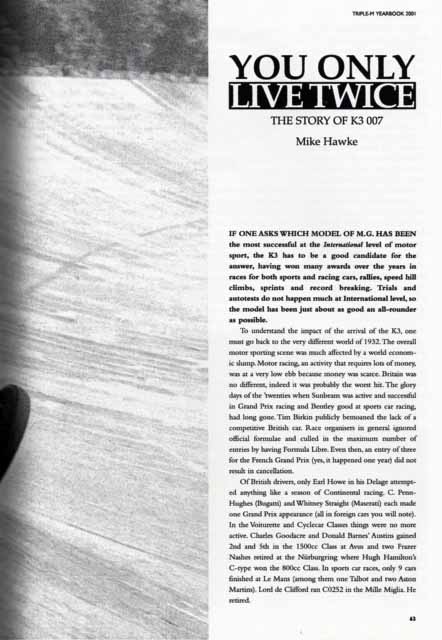
The opening page to Mike Hawke’s nine page article on the history of K3007. This article appeared in the 2001 MG Triple-M Yearbook. Source: Triple-M Yeabook 2001 – RMA Collection
DRAFTING BOARD
Jennings returned to Kuala Lumpur on 20 June 1946. The MG PB and K3 had gone missing during the war and one way to seek the recovery of lost property was to put an advert in the local newspapers, suggesting that he had not lost interest in his pre-war MGs. His advert appeared in the Straits Times of 23 September 1946 (pg. 3). “REWARD OFFERED. To anyone giving Information leading to the recovery of (a) a Monington Weston short compass piano. (b) Motor Car M. G. K3 (B. 3335) (c) Motor Car M. G. P. B. (S. 724) Capt. C O. JENNINGS. Town Board, Kuala Lumpur.”
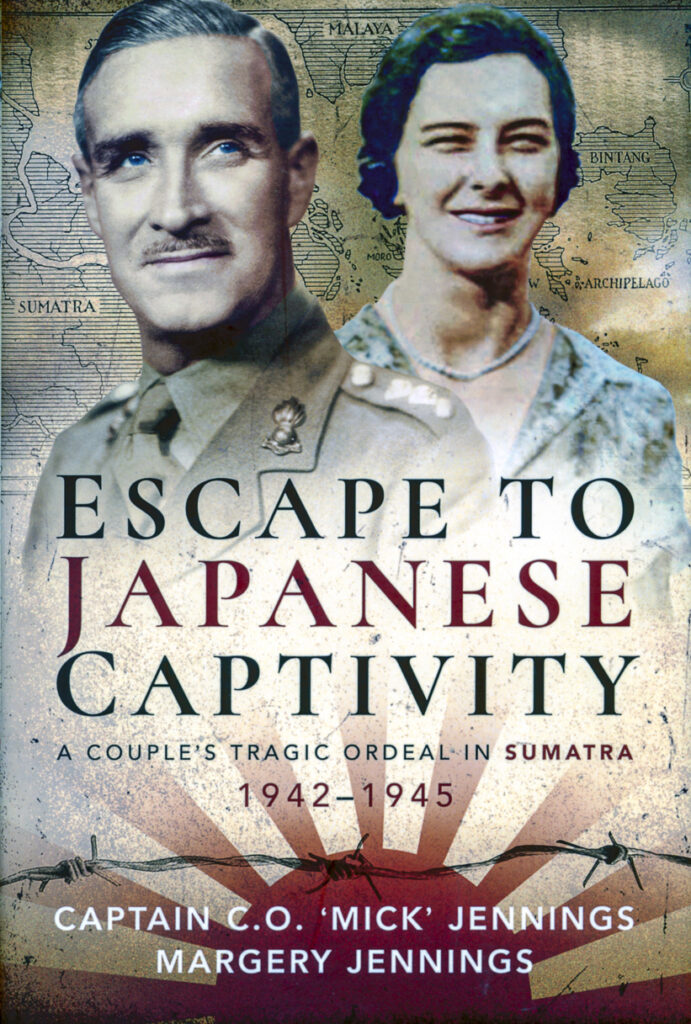
The secret diary Margery Jennings was the basis of Escape To Japanese Captivity. Available @ https://www.pen-and-sword.co.uk/Escape-to-Japanese-Captivity-Hardback/p/18441
During his repatriation home to Yorkshire from Changi POW Camp in September 1945, Jennings met Ruth Stay, a Red Cross nurse on board the ship taking passengers back to Britain45. They were married in the UK and had their first child, Sally, in October 1946. Jennings returned to Singapore on 20 June 194646, now Municipal Architect and building inspector of the Kuala Lumpur Town Board.47 Ruth and Sally made the long journey to Malaya shortly after, arriving in Penang on 11 March 194748. Jennings drove his newly acquired MG TC to Penang to welcome his new family but with no accommodation available in the city, he was forced to spend the night on board the vessel. The family headed back to Kuala Lumpur the next day over the bumpy, pot-holed road that had yet to be repaired after the war. There was a stop at Ipoh for lunch and a short stint in a hotel bedroom to feed the baby. And this is where our story temporarily ends.
END OF PART I

Mick Jennings in his post-war Black Draught MG TC Special with XPAG motor. The photo reveals the Selangor Motor Sports Club badge to the right of the “21” roundel, predating the formation of the Malayan Motor Sports Club (established 18 March 1953). Source: RMA
PART II will reveal Jennings’ return to Malaya in 1946 and the resumption of motor racing in the region, his Black Draught Specials, and his activities in Selangor.
Words by Eli Solomon
You can reach the author @ eli@rewind-media.com
The writer owns a couple of pre-war MGs. – an ex-Scotland Yard MG J2 and an early TA (Special).
References & Related Links
Jennings, Captain C.O. ‘Mick’ & Margery. Escape To Japanese Captivity – A Couple’s Tragic Ordeal in Sumatra 1942-1945. Pen & Sword Military (2020).
Jennings, Captain C.O. ‘Mick’. An Ocean Without Shores. Hodder and Stoughton (1950).
Jennings, Ruth & Jennings, Sal & Jennings, Deb. Mickey Boy. Unpublished biography of C.O. ‘Mick’ Jennings (2009).
Gibbs Pancheri, Paul. Volunteer! – The story of one Man’s War in the East. Paul Gibbs Pancheri (1995).
Hawke, Mike. K3007 – You Only Live Twice – The Story of K3007. MG Triple-M Yearbook.
Thornley, Peter J.H. MR.MG a Biography of John William Yates Thornley O.B.E. (1909-1994). Magna Press (2003).
Thornley, John. Maintaining the Breed: The Saga of Mg Racing Cars. Motor Racing Publications Ltd. (1950).
Wiessmann, Karl-Joachim. The Hawke History of MMM Competition Cars. Directa Buldt (2015).
Hawke, Mike. K3 Dossier: A History of MG’s Most Famous Racing Car. Magna Press (1992).
Allison, Mike. The Works MGs: The Illustrated History of Works MGs in Record-BReaking, Trials, Races and rallies. Haynes (2000).
Knudson, Richard. MG Competition Cars and Drivers. Enthusiast Books (2006).
Solomon, Eli. Lost Circuits – Motor Racing Tales From The Far East. Vol.1. Unpublished.
TA 0930 – THE LOST MG TA CREAM CRACKER
MONSTERS & MAVERICKS MALAYAN/SINGAPORE POST-WAR SPECIALS
Acknowledgements
Sally & Deb Jennings, Michael Pancheri, Jeremy Hawke, the late Lim Peng Han, RMA (which holds part of the Lim Peng Han trophy, photo and race program collection)
Footnotes
- Kampong Satu To be Opened. Malayan Tribune, 16 October 1947, pg 19. Malaya’s first batch of pre-fabricated homes at Kampung Satu, on Sungei Besi Road, consisted of 200 houses built to house those who were from the slum areas forced out by the Kuala Lumpur Town Board. The prefab houses were designed by Jennings, the Selangor Building Surveyor. For his efforts he was awarded the O.B.E. in 1948. The appointment was made to celebrate the official birthday of the King, and published in The London Gazette, 4 June 1948.
- An Ocean Without Shores by C.O. Jennings was published by Hodder and Stoughton in 1950. There was a Penguin paperback edition as well as a hardback edition by The Elmfield Press (1974).
- C.O. Jennings was posted to Malaya, arriving in Singapore on the Peninsular & Oriental Steam Navigation Company’s passenger and cargo carrying ocean liner S.S. Rajputana (from London) on Friday 10 May 1935. June’s F.M.S. Government Gazette revealed that he had been appointed Building Inspector, Sanitary Board, Kuala Lumpur. His wife, Margery, arrived in early December 1935 on the S.S. Carthage.
- Cyril Oswald and Margery Jennings gave their first recitals on the Malayan Amateur Radio Society, Kuala Lumpur Station Z.G.E. on 18 February 1936, Marjory giving a piano Duetto and Mick Jennings a song. The Selangor Club Orchestra, under the direction of Mr. J.A. Roetenberg, provided the music.
- For more on the AAM’s activities before the war, see CLUBBING IN SOUTH EAST ASIA
- Fitzroy ‘Roy’ William Newman [b.1906, Kuala Lumpur]. Newman was based in Seremban before the Japanese Occupation. Enlisted Volunteer Forces 8.2 1941. Rank: Sgt 13780 FMSVF 45 Reserve MT Company. Made POW. Sent from Singapore to Thailand with F Force 28.4.43. Returned to Singapore with other survivors 19.12.43. Repatriated to UK. Returned to Malaya in 1947 where he continued to work for Borneo Motors.
- Douglas Slade Ainger [b.1890, Croydon, Surrey. d. 11 October 1976] was a rubber planter in Malaya and a respected member of the motoring community. He was active in the Selangor scene from the 1920s. In the 1920s he was manager of the Segambut Estate, Selangor, later to Killinghall Estate. In 1928 Ainger was Chairman of the Selangor Automobile Association. In 1935 he shipped his car to the UK where he spent five months driving it at various events, including the annual London to Edinburgh 480 mile run. Ainger was later Lieut.-Colonel in the F.M.S. Volunteer force during the war [FMSVF Armoured Car unit]. POW Changi. He returned to Malaya, Killinghall Estate 1946. Returned to UK in 1951, after 36 years as a planter in Selangor.
- Hugh W. Dornhorst L.D.S., R.C.S., was a dental surgeon based in Kuala Lumpur. He arrived from England on 22 October 1936 to join Mr. H.A. Johnson, Dental Surgeon. Hubert Frederick William Dornhorst, L.D.S., R.C.S. (Eng.) – NZ Dental Corps 20th February 1942 – rank Lieutenant. Post-war – Salisbury, South Rhodesia. Married Sheila Kelly of Salisbury.
- Edward Henry Holloway (b.1914), better known as Ted Holloway, was a prominent Eurasian from Singapore. He was born in Singapore and educated at St. Andrew’s School and later at Raffles Institution. When he raced his Holloway Special in 1938, he was just 24 years old. He would have been 35 when he built his post-war Holloway Special in 1949. He retired from motor racing that year but made a fleeting return to the sport in April 1956. He worked at the City Council as a health inspector and had been President of the City Council Services Staff Union (1956-1957). At age 45, he stood for election in the 1959 Singapore General Elections, representing the Liberal-Socialists party. He lost. He had resigned as City Council health inspector to contest the election. Ted’s wife, Martha (b.1924 Martha Florence Buxton), was Principal of St Margaret’s School, and from 1962, the new secondary school (1957-1965).
- James Lunan Ross [b. 1903, Kinloss, Scotland]. Educated at Dollar Academy. Chartered Accountant, Kyle, Plamer & Co. Kuala Lumpur. Later Director of the same, then Managing Director when Kyle, Palmer (formed by Edward P. Kyle and Frederick W. Palmer in 1921) merged with Paterson Simons in February 1961. Ross Lt. FMSVF Signals Battalion. POW Singapore to Thailand. Returned post-war. Returned as Lt-Col. Lived at 5 Stonor Road, KL. Married Marjory Helen Bryce MA 1946, Edinburgh. Returned to Malaya by BOAC/QEA on 12 August 1946 via Burma with rank of Lt.Col. First seen racing at the Seremban Hill Climb (Negri Sembilan Branch of the AAM) in December 1927 in a 495cc Matchless. Then at the Selangor Scramble organized by the S.A.A. in October 192810 CLUBBING IN SOUTH EAST ASIA
- Also referred to as the AAM Singapore Trophy Speed Trials.
- John Keene was Superintending Engineer, Central Electricity Board, Malacca circa 1950. He was already based in Malacca with his first wife before the war and would have known Mick Jennings when they raced together in 1939.
- S.S. Rajputana was requisitioned into the Royal Navy on the onset of World War II and commissioned in December 1939 as the armed merchant cruiser HMS Rajputana. She was torpedoed and sunk off Iceland on 13 April 1941, after escorting a convoy across the North Atlantic. P&O’s mail, passenger and cargo outward bound schedule from London for China and Japan listed the following vessels/dates due in Singapore: Canton, 3 November 1939; Carthage, 17 November 1939, Rajputana, 1 December 1939.
- Ruth Jennings’ Memoirs, unpublished.
- The Blue Funnel Line (in conjunction with the Glen Line) London to Singapore via Marseilles vessel TSS Sarpedon left Liverpool 20 January 1939 and arrived in Singapore 19 February 1940. Jennings’ leave was from June 1939 to January 1940, so it is entirely possible that Jennings’ MG K3 would have been aboard the 11,321-ton cargo liner. Of the four Blue Funnel ships SS Sarpedon, SS Patroclus, SS Hector, and SS Antenorhe, only Sarpedon was not commissioned as an Armed Merchant Cruiser.
- Straits Times, 16 February 1940, pg.10 – Racing Motorist Returning.
- The Hawke History of MMM Competition Cars, Karl-J Wiessmann, Germany.
- Jennings and his wife returned on the TSS Sarpedon in February 1940.
- Proceeds from the event would go towards the Patriotic Fund.
- Lim Khye Su’s SS100, registration P936, carried chassis #18194. Lim was a Penang-based enthusiast, later a Wearne Brothers Service Manager in Penang. The car was a regular entry at various events in North Malaysia, occasionally with a twin rear wheel setup. This car was also entered in the Perak AAM’s Gopeng Hill Climb of 11th April 1939 – so its existence in Malaya can be dated to pre-war. Lim owned the car till the 1950s – which was quite remarkable as Penang had been overrun by the Japanese during the war. The car was eventually purchased by Kenneth Cole of Singapore and registered SX6965.
- See TA 0930 – THE LOST CREAM CRACKER.
- James Henry ‘Jimmy’ Wheeler [b. 1913]. Repair Manager Borneo Motors Ltd October 1937. Possibly in Singapore/Straits Settlements since 1935. Later to Sales Department of Borneo Motors, 68-70 Orchard Road, Singapore. Returned to Singapore after the war and became Borneo Motors’ Managing Director (retired April 1956). James Wheeler married Rosemary (Johnny) French of West Kirby, Cheshire in Singapore, 23 December 1946. Wedding reception held at 42 Nassim Road, Singapore.
- Alfred Giles Faber [b. 1901]. MD, Federal Motor Garage, Pudu Road, KL and Ipoh. Lived in Ipoh. Captain 2FMSVF POW Singapore to Thailand. Repatriated via India. Alfred Giles Faber [b.1901] Norton, Stockton-on-Tees. Engineer in Ipoh 1920s. Married Carlotta Holzmann Mosselbay of South Africa 1 November 1928 in Penang. Faber based in Ipoh at that point, listed as an engineer. Carlotta arrived Penang on the Malwa. Faber was Managing Director, Federal Motor Garage Ltd, Pudu Rd, Kuala Lumpur and Ipoh. Lived at 2 Edgar Rd, Ipoh. Wife Carlotta & son [Henry Faber] b. October 1936 at Batu Gajah Hospital. Both evacuated to Ooty, India via Ceylon before the war [on the USS West Point]. Captain 2FMSVF POW Singapore to Thailand with U Party 28.10.42. Son of Colonel H.G. Faber of Stockton-on-Tees. Repatriated via India. Carlotta died 1988 London. 1936-1937 – In charge of Federal Motor Garage, Ipoh. January 1941 – Faber was Managing Director of Federal Motor Garage Ltd, Kuala Lumpur.
- [1] Photo in MVCR Gazette, June 1965 shows C.O. Jennings’ #37 MG K3.
- Arthur William Beven [b.1908, Singapore]. He was a Sales Manager/Accountant at office equipment company Roneo Ltd. at Malacca St. Singapore, and a well-known Malayan amateur jockey from 1926.
- Died 05/03/1943, age 25. 1H.A.A. Regt.Hong Kong and Singapore Royal Artillery. Peter was son of Lancelot Ambrose Scudamore Jermyn, and of Agnes Jermyn, of Exmouth, Devon. He died at Ballale Island in the Shortland Islands Group in the Western Province of the Solomon Islands on on 5.3.1943. A work party of 517 British prisoners of war from various artillery regiments captured after the Battle of Singapore were transported to the island under the command of 45-year-old Lt. Col. John Bassett to build an airfield. When the airfield was completed the prisoners, including their commander Bassett, were executed. The mass graves were discovered after the war. Japanese authorities claimed that the prisoners were lost at sea when their transport was torpedoed.
- Photo of the car found in The Singapore Free Press and Mercantile Advertiser, 13 November 1940, Page 10.
- Royal Army Service Corp.
- Jennings trained in Bedford in the UK under the Royal Engineers and apparently spent the latter part of the Great War in Mesopotamia. He was a surveyor in the Sudan in 1924, then the West African Gold Coast between 1926 and 1930 before being recalled to England during the depression. He was posted to Malaya in 1935. In Singapore, following the onset of war with Germany, Jennings tried to enlist in the Royal Engineers and was put on the Reserve List of officers, the Colonial Office refusing to release him from his municipal duties. When war became eminent in Malaya, he was recalled to the Royal Engineers in preparation for a possible Japanese invasion. His task as a Sapper was to organise a scorched earth policy from the north of the Peninsula all the way down to the south, the objective being to blow up bridges and the floating dredges in the tin mines.
- ZHL was the station of the newly-licensed (March 1937) British Malaya Broadcasting Corporation Ltd (BMBC), Singapore.
- Celeste Amstutz left Singapore on 19 January 1942, via India and Durban before finally reaching the United States of America. Margery Jennings often refers to the Amstutzs in her diary. On 30 January the Jennings moved to stay with Gertrude Hinch and her husband, Thomas. It appears that Mr Hinch and Mick Jennings made the decision that their wives should leave Singapore.
- Ping Shan in Cameron Highlands was the highland home of the Ho family. It consisted of four-room, had hot running water, modern sanitation, electricity, radio and a cook. The house was at ¾ mile, Ringlet Village.
- Dr Ho Seng Ong, OBE, EdD, MA, PRGS, was the Principal of the Malacca Anglo-Chinese School from 20th January, 1930 to 31st August, 1946.
- Morning Tribune of 21 October 1941, pg11 notes that Ipoh is the new home of Capt. and Mrs C.O. Jennings.
- The Japanese 25th Army moved into northern Malaya and Thailand by amphibious assault on 8 December 1941. Penang was bombed daily by the Japanese from 8 December, and the British forces hastily abandoned the island on 17 December 1941. Kuala Lumpur fell unopposed on 11 January 1942, by which time Jennings had reached Singapore.
- Thomas William Hinch (1887-1970) who was the first non-missionary expatriate Principal of the Anglo-Chinese School in Singapore from 1929 to 1946 (interrupted by the war of course). His wife, a friend of Margery Jennings, was Gertrude Bean Hinch (b. 18 April 1890/1891 in Milwaukee, Wisconsin, USA). In 1912 Gertrude graduated from Carroll College with a Bachelor of Arts degree. At the time of the Japanese invasion, she was President of the Malayan Committee of the YWCA. At the start of 1942 she was conferred with an O.B.E. (Civil Division).
- Lieut. Colonel Clement Alfred Mead, Royal Engineers [b. 17 December 1899 – d. 19 September 1986]. Mead married Joyce Marguerite Vanrenen on 16 April 1932 in South Kensington. Vanrenen’s father was Colonel A.S. Vanrenen, at one point in command of the Malay States Guides (in the early 1930s). Colonel Mead was sent to Malaya in the first half of 1939. During the war, Mead was a POW in Taiwan and China.
- It must have been around May 1942 or later, after Paul Gibbs Pancheri and Jumbo Lang had been sent to work at the River Valley Road Camp after Changi, that the MG K3 was spotted. “One morning, Jumbo Lang – a fellow motoring enthusiast – and I discovered in the garage of the Hong Kong Bank Mess [at Sri Menanti, off Jervois Road], Mick Jennings’ K3 MG Magnette, a really fine racing car which had competed in hill climbs in Singapore before the war. Alas, all we could do was to admire it and hope that it might be spared, but I’m afraid it was shipped off to Japan…” Volunteer! The Story of one Man’s War in the East. Paul Gibbs Pancheri, 1995 (p.69). It stands to reason that Jennings would have brought the MG K3 down to Singapore when he and Margery vacated their government bungalow in Kuala Lumpur. The Hong Kong & Shanghai Bank Mess was a 10ha. area situated at 325 Tanglin Road. The house, in which the Manager of the Singapore Branch of the bank stayed, was called Mount Echo. Prior to surrender in February 1942, the house was briefly used as a British Military hospital. Following surrender, it was occupied by a Japanese General. Based on Gibbs Pancheri’s account, the K3 might have been stored there before surrender or it may have been requisitioned by the Japanese after surrender and kept by a General who knew his MGs and racing cars. The Jennings last stayed with Thomas and Gertrude Hinch in Singapore before the surrender to the Japanese in February 1942.
- Ibid.
- Ibid.
- Laburnum Wharf was situated to the seaward side of Telok Ayer Basin. The Headquarters’ Ship of the Malayan Royal Naval Volunteer Reserve, HMS Laburnum. As drill ship, Laburnum was equipped with independent wireless equipment, and housed a number of naval offices including Captain, Auxiliary Vessels and Captain, Extended Defences Office. Laburnum had her engines removed shortly after her arrival in Singapore in order to augment her accommodation. Hence she could not be fully utilised when war broke out in the Far East. With the evacuation of Penang, Laburnum also played host to the RNVR Penang Division, headed by Commander C C Alexander. Labernum was scuttled on 15 February 1942 when Singapore fell to Japanese forces. Her wreck was raised about 1946, and sunk off East Lagoon, Singapore, as part of an existing breakwater of old hulks, and finally removed and scrapped about 1967.
- An Ocean Without Shores.
- The Mata Hari, a small coastal steamer, left Singapore at 7.30pm on Thursday 12 February 1942, preceded by the Vyner Brooke, destination Batavia. The Mata Hari was one of the last of some 47 small ships to leave Singapore all of which were overloaded with evacuees. Ahead of her were HMS Scorpion, Vyner Brooke and Giang Bee with orders to proceed to Batavia via the Durian and Banka Straits. For details on the capture of HMS Mata Hari see: http://muntokpeacemuseum.org/wp-content/uploads/2016/12/My-father-and-the-Mata-Hari-v5-public-version-1.pdf
- Jennings was repatriated on armed merchant cruiser HMS Antenor from Singapore, arriving Liverpool 27 October 1945, the Japanese surrender in Singapore having taken place on 12 September 1945. Ruth Stay’s memoirs confirm they landed “…about 23 October, having to wait outside the bar for three days – they were the 23rd ship bringing POWs to arrive. And the mayor and corporation met them while the band played the MIKADO!”
- Jennings arrived in Singapore on the Empress of Australia on Thursday 20 June 1946. On board the same vessel were Thomas and Gertrude Hinch as well as John Wishart, President of the Negri Sembilan Branch of the AAM.
- It appears that on Jennings and Margery’s return to the UK on leave in 1939, he received “three months intensive coaching before sitting for five years’ worth of architectural exams at one go.” His daughter Sally revealed that he passed all but one of these, which he re-sat in Singapore following his return.
- Ruth Jennings’ Memoirs, unpublished.

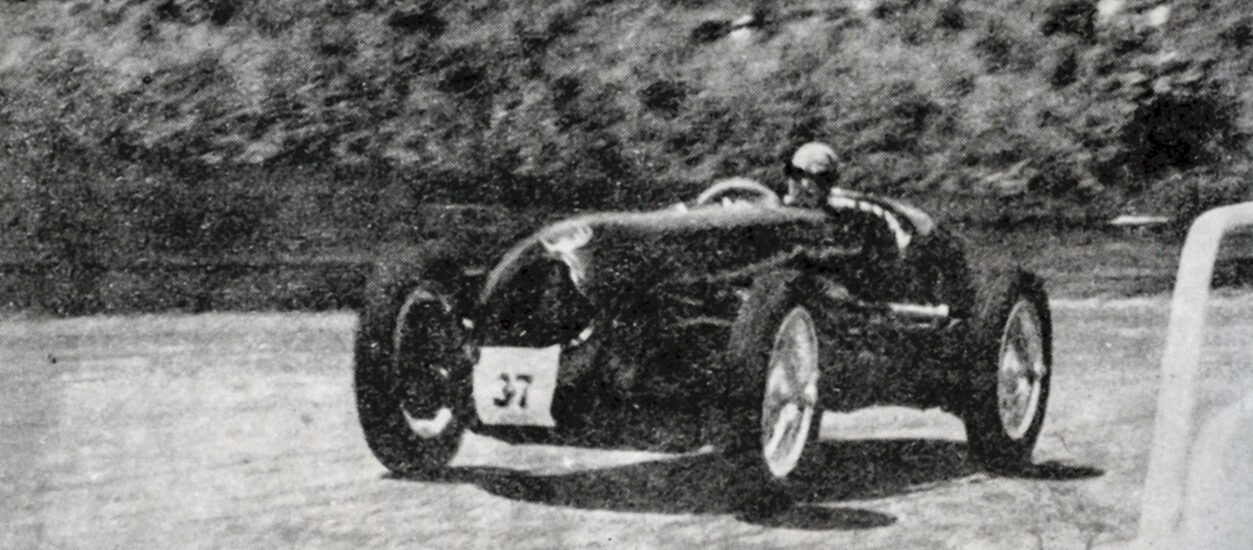
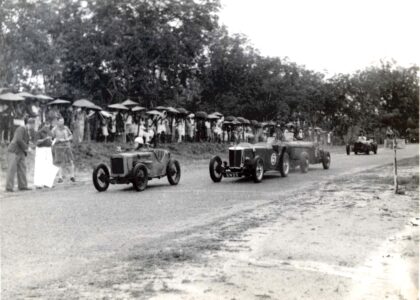
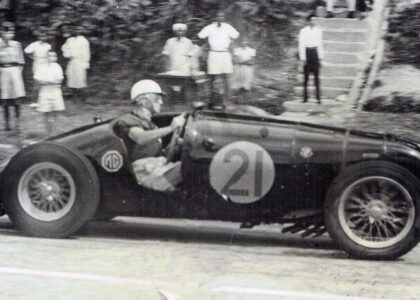
3 thoughts on “THE REAL CAPTAIN MG – PART I”